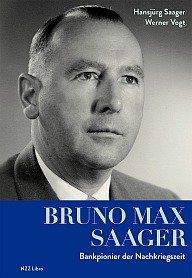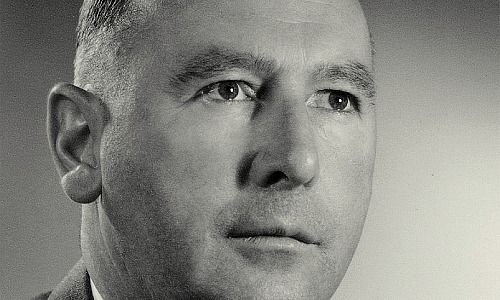The negative focus on the recent series of scandals affecting Switzerland's biggest banks --UBS and Credit Suisse -- means the achievements of some of more renowned bankers are often forgotten. A new biography should help right this wrong.
Alfred Schaefer, Robert Holzach and Bruno Saager represent the triumvirate who probably did most to shape the excellent reputation of the Schweizerische Bankgesellschaft (SBG, today's UBS) in the 20th century. So it's even more surprising that their efforts have largely been forgotten.
Such is the current short-term focus on the contributions made to the financial system that the efforts made four or five decades ago have largley been relegated to the footnotes in the history of the Swiss economy.
Boerse Head With a Flair for the Foreign
Following on the biography of Robert Holzach – written by the current authors –is a comprehensive biography of former SBG boerse head Bruno M. Saager, and one which is of great significance to the history of Swiss banking.
This was a man with considerable know-how who made an enormous contribution to SBG's expansion abroad, and who is largely responsible for propelling it to a premier position among the country's financial institutions.
Valuable Witnesses
It is also worth noting the biography was written by Saager's son Hansjürg Saager, who has recently passed away, and former NZZ-Editor and South Africa expert Werner Vogt, giving the work valuable access to participants and information which has thus far been hidden from public view.

Saager, unlike most other banking executives, wasn't an academic and had no military connections, but possessed a healthy pragmatism and a nose for lucrative investments. He realized the opportunites the German post-war recovery might offer and made investments for both SBG and private individuals, in German firms, which later delivered healthy profits.
Saager's German Deutschland expertise was also key during the 1960s in the tough negotiations between SBG and the US government over the ownership Interhandel firm. Simply put, it originally involved a Swiss participation in the German I.G.-Farben-Konzern, which had produced toxic gasses for German concentration camps during World War II.
Negotiations With Robert F. Kennedy
During the war years the foreign holdings of Interhandel in I.G. Farben/Chemie were consolidated and later listed on Swiss exchanges. Die US-holdings were confiscated by the US government, which then led to disputes on whether the listed assets belonged to the Americans or the Interhandel shareholders, most of whom were held by SBG and Saager.
Up to now it has barely been known that it was the former SBG-President Alfred Schaefer who negotiated an agreement with the then US Justice Minister Robert F. Kennedy. The two agreed the US assets be split evenly between the Swiss bank the US, a deal which helped inject the capital which helped make SBG Switzerland's largest financial institute.
Recognized Contribution
Saager and Vogt describe how Saager was largely to thank for the breakthrough in the Interhandel talks with the Americans, a view later corroborated by US diplomats and lawyers present during the negotiations.
Along with the German Dossier and the Interhandel wrangle, South Africa represented the third issue in which Saager made a significant impact as far as SBG history is concerned.
Like his post-war approach to Germany, Saager realized the economic opportunities in South Africa, albeit this potential was overshadowed by the Apartheid policies of the government.
Politically Controversial
Against this background the involvement of SBG in the South African gold and raw materials sectors were amongst the most active of all foreign banks, and a constant subject for dispute. The issue was highlighted in the left-wing book «Ganz oben – 125 Jahre Schweizerische Bankgesellschaft» published in 1987.
While Saager argued that an economic engagement in Apartheid South Africa was the only way to overcome the government's policy and help integrate the black community, the authors of the 1978 book highlighted many of the, some illegal, business pratices conducted in South Africa by SBG.
Room to maneuver
The truth probably lay somewhere in the middle. Because of the global connections associated with South Africa, the room to maneuver for banks like SBG were much greater then than would now be the case for countries operating under sanctions.
This probably also enabled SBG managers to easier test the business limits than would be the case today. Nobody today would contest the view that economic engagement in a totalitarian state contributed more to its transformation into a true democracy than pure political pressure.
Saager did enjoy excellent relations with the leading South African business heads, including Anton Rupert and Harry F. Oppenheimer as well as with political figures like Pieter W. Botha and John Vorster, and pushed for stronger links between the two countries.
The fact he had personal engagements, and in fact owned a wine farm, in South Africa underlined his talent as a bank manager for recognizing good business opportunities.
Lacking the Charisma
Like his colleagues Schaefer and Holzach, Saager's name and standing in the present banking sector enjoy little recognition. This certainly has to do, on the one hand with nature of some of the activities he was involved in, but also because he lacked the charisma and ability to publicise his achievements. This in the longer run hampered his career.
In his prime he was a doer, a pragmatist and a negotiator, all roles which he enjoyed more than being in the spotlight, or looking down as chairman of the board or supervisory chairman of SBG, where he would have had influence on the bank's activities.
While Saager made a dignified exit from SBG, he was never accorded the esteem his work deserved. Born in 1908, Saager died in April 1991. The book, published in early April, also offers an insight into the workings of the bank during the 1960s and 1970s, with plenty of anecdotes which former SBG employees will read with pleasure.
«Bruno Max Saager – Bankpionier der Nachkriegszeit», Hansjürg Saager and Werner Vogt, 270 pages, NZZ-Verlag, 2017; 44 chf.






























